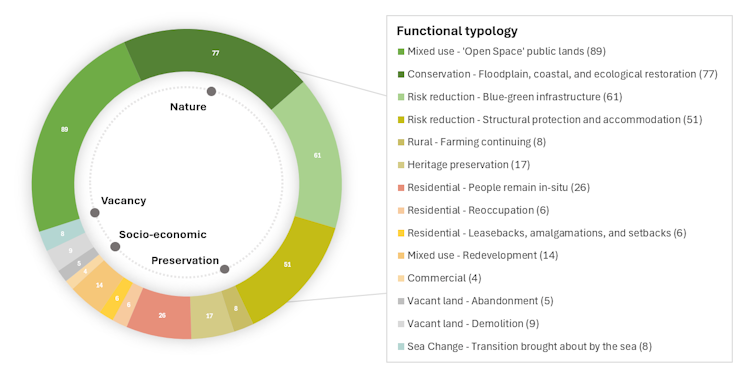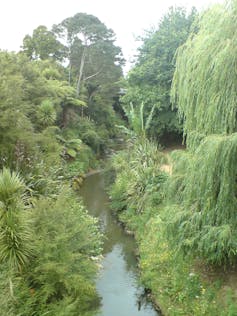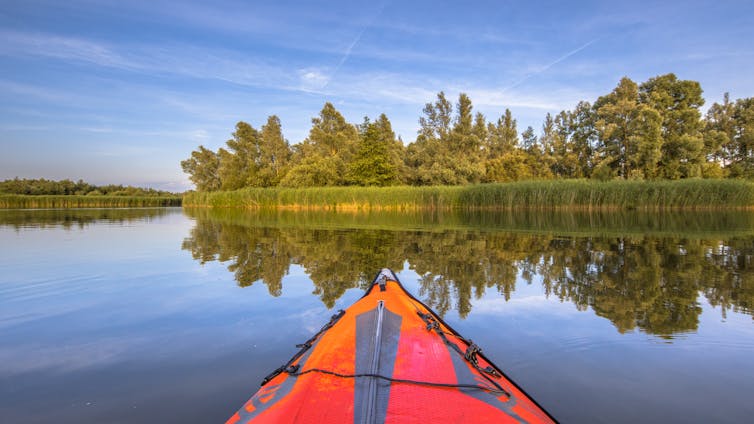
Once floodwaters subside, talk of planned retreat inevitably rises.
Within Aotearoa New Zealand, several communities from north to south ÔÇô including , and parts of ÔÇô are considering future relocations while others are completing property buyouts and categorisations.
Planned retreats may reduce exposure to harm, but the social and cultural burdens of dislocation from land and home are complex. Planning, funding and physically relocating or removing homes, taonga or assets ÔÇô and even entire towns ÔÇô is challenging.
Internationally, research has focused on , and planned retreats occur, as well as . But we explore what happens to the places we retreat from.
Our latest examines 161 international case studies of planned retreat. We analysed what happens beyond retreat, revealing how land use has changed following withdrawal of human activities.
We found a wide range of land use following retreat. In some cases, comprehensive planning for future uses of land was part of the retreat process. But in others we found a failure to consider these changing places.
Planned retreats have happened in response to various climate and hazard risks, including sea-level rise and coastal erosion, tsunami, cyclones, earthquakes, floods and landslides.
The case studies we investigated range from gradual transitions to sudden changes, such as from residential or business activities to conservation or vacant lands. In some cases, ÔÇťsea changeÔÇŁ is evident, where once dry land becomes foreshore and seabed.
Through our research, we identified global ÔÇťretreat legaciesÔÇŁ. These themes demonstrate how communities across the world have sought similar outcomes, highlighting primary land-use patterns following retreat.

Nature legacies
The case studies show significant conversions of private to public land, with new nature and open-space reserves. Sites have been rehabilitated and floodplains and coastal ecosystems restored and reconnected.
Open spaces are used for various purposes, including as nature, community, stormwater or passive recreational reserves. Some of these new zones may restrict structures or certain activities, depending on the risk.
For example, due to in Matat─ü in the Bay of Plenty, only transitory recreation or specific low-risk activities are allowed in the post-retreat environment because of the high risk to human life.
Planning and investment in new open-space zones range from basic rehabilitation (grassed sites) to established parks and reserves, such as the which borders rivers in the twin US cities of Grand Forks, North Dakota, and East Grand Forks, Minnesota. This area now hosts various recreational courses and connected trails as well as major flood protection measures.

Nature-based adaptations are a key function in this retreat legacy. For example, , a large-scale environmental restoration project in Waitakere, West Auckland, has transformed former residential sites into drainage reserves to make room for rivers in the floodplain.
Importantly, not all retreats require significant land-use change. Continued farming, heritage preservation and cultural activities show that planned retreats are not always full and final withdrawals from a place.
Instead, they represent an adapted relationship. While sensitive activities are relocated, other practices may remain, such as residentsÔÇÖ continued access to the for fishing and farming.
Social and economic legacies
Urban development in a small number of retreated sites has involved comprehensive spatial reorganisation, with planning for new urban esplanades, improved infrastructure and cultural amenities.
One example is the for the Ca├▒o Mart├şn Pe├▒a district in San Juan, Puerto Rico, which involves communities living along a tidal channel. The plan applied a community-first approach to retreat. It integrated infrastructure, housing, open space, flood mitigation and ecological planning.
Alternatively, the decision to remove stopbanks and return the landscape to a ÔÇťwaterscapeÔÇŁ can become a tourism feature, such as in the marshlands of the Biesbosch National Park in the Netherlands. A is dedicated to the transformed environment.

Where there was no post-retreat planning or site rehabilitation, ghost towns such as leave eerie reminders of the costs of living in danger zones.
also raise environmental justice and ecological concerns about which retreat spaces are invested in and rehabilitated to avoid urban blight and environmental risks. Retreat sites may include or contaminated land, requiring major site rehabilitation.
The 12 case studies from Aotearoa New Zealand demonstrate a range of new land uses. These include new open-space reserves, the restoration of floodplains and coastal environments, risk mitigation and re-development, and protection measures such as stopbanks.
Moving beyond retreat
Our research highlights how planned retreats can create a transition in landscapes, with potential for a new sense of place, meaning and strategic adaptation.
We found planned retreats have impacts beyond the retreat site, which reinforces the value of spatial planning.
The definition and practices of ÔÇťplanned or managed retreatÔÇŁ must include early planning to account for the values and uses the land once had. Any reconfigurations of land and seascapes must imagine a future well beyond peopleÔÇÖs retreat.![]()
, Senior Lecturer in Environmental Planning, ; , Professor of Environmental Planning, ; , Senior lecturer in Environmental Planning, , and , Senior lecturer in Environmental Policy,
This article is republished from under a Creative Commons license. Read the .



